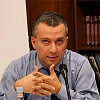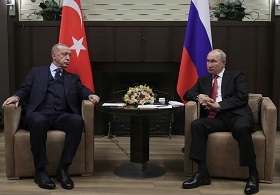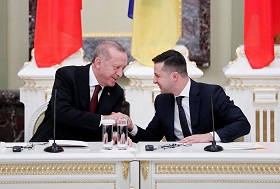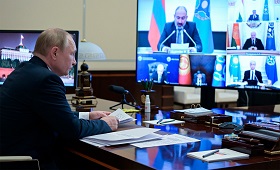The outcomes of the 2020 Karabakh war have not only upset the regional status quo, but they also continue to threaten Russia’s security in the post-Soviet space. Although still afloat, the current Armenian government is weak, and it has failed to inspire the popular confidence that it once commanded in the heady days of spring 2018. The defeat in the recent war dealt it a significant blow, and it left the country’s geopolitical clout in tatters, with formidable challenges and growing ambiguities in its foreign and security policy. Socioeconomic concerns, a major driver for the 2018 “Velvet Revolution,” remain unresolved. As inflation rises at an alarming rate, the latest statistics show the country’s unemployment rate at 15%, the highest in the EAEU.
If Yerevan were to continue its “new era” course and neglect its vital national security interests in Nagorno-Karabakh and Syunik, it will not only risk transforming Armenia into a Turkish client state, as this will also threaten to end Russia’s presence in Transcaucasia, creating a new Turkey-NATO threat on Russia’s southern frontiers. Currently, NATO stands a mere 135 kilometers (84 miles) from Peter the Great’s “window to Europe,” St. Petersburg. With an active support of the ambitious Ankara, it could soon follow this act by reaching within a short distance of historical Derbent, Russia’s southernmost city. Indeed, although it regularly dons the guise of an “independent player,” Turkey is a master of the double-talk (even triple-talk) of the Eastern bazaar. While charming Kremlin officials with Turkish delights, its actions show that it fully backs NATO’s bid to oust Russia from the post-Soviet space.
Nevertheless, Moscow’s swift reaction to the recent turmoil in Kazakhstan dealt a significant blow to Ankara’s ambitions in post-Soviet Eurasia and the “Turkic World.” A possible path forward would be to strengthen the strategic alliance between Russia and Armenia, with the aim of preventing Turkey, and by extension NATO, from establishing any domination in the post-Soviet Transcaucasia. Such a scenario would envision a complete strategic coordination between Moscow and Yerevan on several key fronts, including:
I. Preservation and protection of the Armenian population on the historical Armenian homeland, especially in Nagorno-Karabakh and the southern Armenian provinces of Syunik and Vayots Dzor.
II. Russian–Armenian military harmonization.
III. Restriction of Turkish economic penetration and control into the Armenian Republic.
This July will mark the 300th anniversary of Peter the Great’s Caspian campaign. The campaign proved costly for the Russian emperor in terms of lives and resources, and the outcome was disappointing. Nevertheless, the events of July 1722 marked a key moment for Russia’s southern expansion, with an eye toward the eventual incorporation of the Caucasus. In his campaign, Peter commanded the loyalty of regional allies – the Georgian King Vakhtang VI and the leaders of the Armenian principalities of Syunik and Khachen (approximately corresponding to today’s Nagorno-Karabakh). Three hundred years later, the latter two Armenian regions are once again at the center of Russian security policy in Transcaucasia, amid growing threats from the increasingly ambitious NATO member Turkey.
The outcomes of the 2020 Karabakh war have not only upset the regional status quo, but they also continue to threaten Russia’s security in the post-Soviet space. Although still afloat, the current Armenian government is weak, and it has failed to inspire the popular confidence that it once commanded in the heady days of spring 2018. The defeat in the recent war dealt it a significant blow, and it left the country’s geopolitical clout in tatters, with formidable challenges and growing ambiguities in its foreign and security policy. Socioeconomic concerns, a major driver for the 2018 “Velvet Revolution,” remain unresolved. As inflation rises at an alarming rate, the latest statistics show the country’s unemployment rate at 15%, the highest in the EAEU.
Recent poll findings from the International Republican Institute reflect the growing popular mood. 46% of Armenians agree that their country is not going in the right direction, a significant blow to the republic’s sitting leadership. Of those surveyed, 88% stated that the top national security threat facing Armenia is the Turkish Republic. Only 5% say that Armenian-Turkish dialogue is necessary, while the vast majority say that the government should instead invest its greatest effort in enhancing Armenia’s strategic security alliance with the Russian Federation. The poll findings echo popular sentiments on the streets of Yerevan, as residents express comfort with the regular flights of Russian MiG-29 fighters over the skies of the Armenian capital. By contrast, the government’s proclaimed “new era of peace” with Turkey has invited considerable concern, and even apprehension, among the population, given not only the memory of Turkey’s direct involvement in the 2020 Karabakh war, but also the 1915 Armenian Genocide, which Ankara still denies.
If Yerevan were to continue its “new era” course and neglect its vital national security interests in Nagorno-Karabakh and Syunik, it will not only risk transforming Armenia into a Turkish client state, as this will also threaten to end Russia’s presence in Transcaucasia, creating a new Turkey-NATO threat on Russia’s southern frontiers. Currently, NATO stands a mere 135 kilometers (84 miles) from Peter the Great’s “window to Europe,” St. Petersburg. With an active support of the ambitious Ankara, it could soon follow this act by reaching within a short distance of historical Derbent, Russia’s southernmost city. Indeed, although it regularly dons the guise of an “independent player,” Turkey is a master of the double-talk (even triple-talk) of the Eastern bazaar. While charming Kremlin officials with Turkish delights, its actions show that it fully backs NATO’s bid to oust Russia from the post-Soviet space.
Nevertheless, Moscow’s swift reaction to the recent turmoil in Kazakhstan dealt a significant blow to Ankara’s ambitions in post-Soviet Eurasia and the “Turkic World.” In quick order, Kazakhstan’s President managed to gain control over the situation in close coordination with Russia and the CSTO. The episode vividly underscored the importance that Russia attaches to the post-Soviet space as its primary zone of vital national security interests. It also highlighted the reality that, in today’s multipolar world, Turkey, despite all the talk of becoming an independent regional power, will continue to assume its position as the bulwark of NATO in post-Soviet Eurasia, rather than join any rival—Russian or Chinese—pole. These basic geopolitical realities will remain unchanged, regardless of how many Russian tourists flock to Antalya or how many cubic meters of Russian natural gas are transported through Turkey.
Such an environment begs the question: chto delat? What is to be done? A possible path forward would be to strengthen the strategic alliance between Russia and Armenia, with the aim of preventing Turkey, and by extension NATO, from establishing any domination in the post-Soviet Transcaucasia. Such a scenario would envision a complete strategic coordination between Moscow and Yerevan on several key fronts, including:
I. Preservation and protection of the Armenian population on the historical Armenian homeland, especially in Nagorno-Karabakh and the southern Armenian provinces of Syunik and Vayots Dzor. To this end, Yerevan can work in coordination with Moscow to promote economic development and job opportunities to incentivize population growth and discourage emigration. Moreover, the enhancement of Moscow’s territorial control of Karabakh to further secure the civilian population could act as a powerful incentive to prevent out-migration, from both Karabakh and Armenia’s southern provinces.
II. Russian–Armenian military harmonization. This scenario envisions Yerevan working in tandem with Moscow to promote greater coordination in military affairs, especially in the spheres of air defense, tactical training, and military intelligence. To that end, a joint Russian-Armenian military command center could be established at Kapan, capital of the Syunik Province. Such a center would provide a “half-way” point, connecting the men of the forces of the 102nd Russian Base at Gyumri with those of the Russian peacekeeping forces in Karabakh, as well as the Russian pogranichniki (border troops) serving on the Turkish, Iranian, and Azerbaijani borders. Moreover, it would enhance the security of the civilian population of Syunik. Besides, Yerevan must work to ensure the indefinite deployment of Russian peacekeeping forces in Karabakh. All of this would establish Armenia as a secure link in Russia’s defense architecture in post-Soviet Eurasia. The life and safety of every Armenian civilian—man, woman, and child—depends on close cooperation and coordination between all branches of the Armenian and Russian militaries, down to the common soldier.
III. Restriction of Turkish economic penetration and control into the Armenian Republic. Conversely, the role of Russia and the EAEU in the economic life of Armenia should be enhanced, with the aim of promoting economic growth and opportunity, as envisioned in Point I. Naturally, Armenia and Russia should both be interested in Yerevan normalizing relations with Turkey and Azerbaijan, but not at the expense of Armenian or Russian vital national security interests. In that respect, Moscow and Yerevan share the common aim of preventing Turkey’s dominance in the Caucasus. Yerevan especially should never neglect its duty to protect the civilians of Nagorno-Karabakh and their right of self-determination for the sake of dubious “economic benefits” with Ankara.
Any cursory study of vital Russian and Armenian national interests proves that such a strategy is essential to both sides. For the broader Armenian community, it ensures the defense and continued physical existence of the Armenian people on their historical homeland. For Russia, it cements its presence as the preeminent force in Transcaucasia, guaranteeing security on its southern frontiers, while ensuring against encroachments by Ankara and NATO into Central Asia. The realization of such a strategy requires robust diplomacy on the part of both Moscow and especially Yerevan. Both sides should not wait to cement this process. As the great Armenian diplomat and Syunik native Israel Ori proved in his service to Peter the Great, no challenge is insurmountable.








